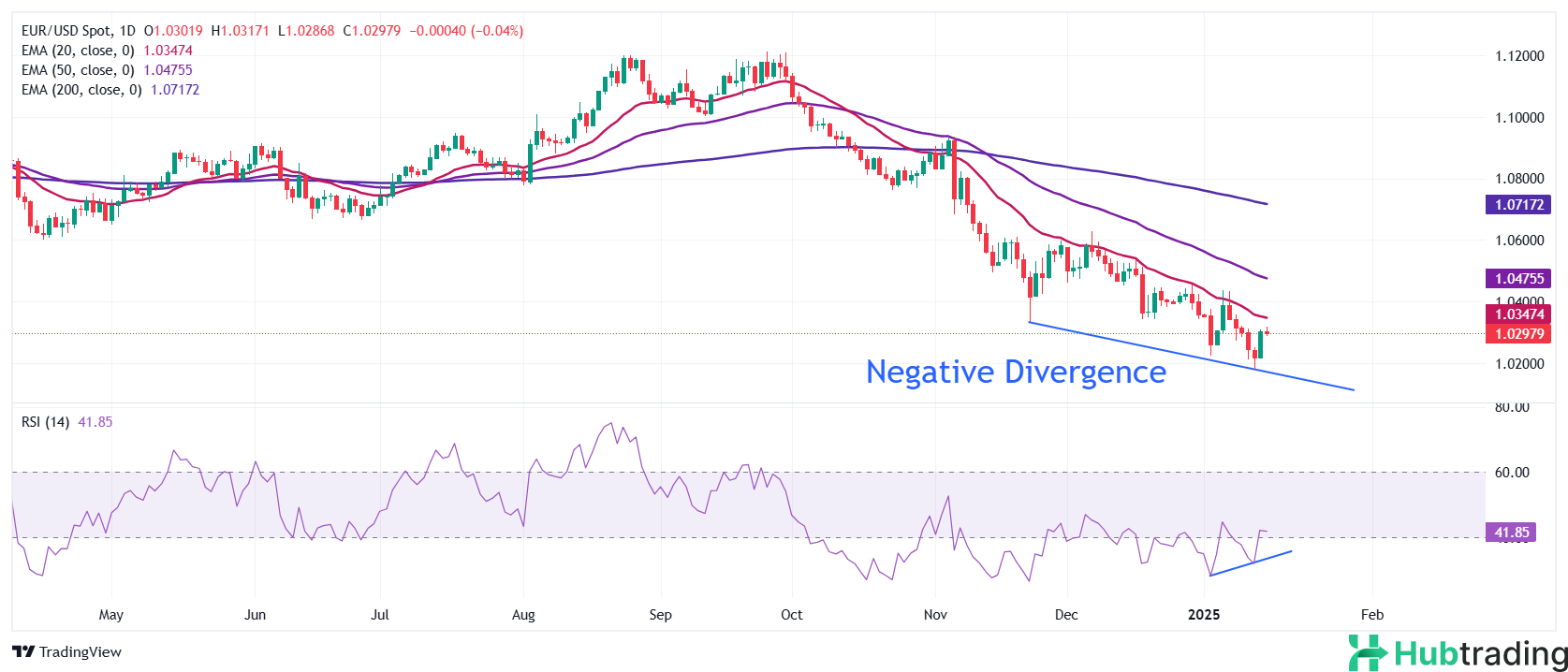- EUR/USD secures key resistance at 1.0300, rebounding from a two-year low of 1.0175 as markets await December's US CPI data.
- The US Dollar weakens following December's softer-than-expected PPI figures.
- ECB’s Holzmann cautions that reaching the neutral rate may be a challenging journey.
EUR/USD remains steady near 1.0300 as the US Dollar weakens, though the Euro struggles against other major currencies on Wednesday. Investors exercise caution ahead of President-elect Donald Trump's return to the White House, with expectations that higher import tariffs under his administration could hurt Eurozone exports by making them more expensive for US buyers.
Concerns over slowing Eurozone economic growth and subdued inflation pressures have fueled expectations of further rate cuts by the European Central Bank (ECB) this year. Following a 100-basis-point reduction in its Deposit Facility rate in 2024, the ECB is anticipated to cut another percentage point by mid-summer, bringing rates to 2%.
During Wednesday's European session, ECB policymaker François Villeroy de Galhau, Governor of the Bank of France, stated that reaching a 2% interest rate by summer "makes sense" as inflation is nearly under control. However, he warned of growing "downside risks" to France’s growth outlook, though he does not foresee an imminent recession.
While many ECB policymakers align with expectations for a 25-basis-point cut at each of the next four policy meetings, Austrian Central Bank Governor Robert Holzmann cautioned that the path to lower rates is not as “straightforward as it seems.” He noted that core inflation remains “closer to 3% than 2%” and flagged energy-related challenges that could influence the ECB’s rate decisions.
Daily Digest Market Movers: EUR/USD Steady Ahead of US CPI Data
-
The pair remains near 1.0300 during Wednesday’s European session, consolidating after Tuesday’s strong recovery. Traders are focused on the upcoming US Consumer Price Index (CPI) data for December, set for release at 13:30 GMT. This data will be crucial in shaping expectations for the Federal Reserve’s (Fed) monetary policy outlook.
-
Headline inflation is projected to rise 0.3% month-on-month, with core CPI (excluding food and energy) expected to increase by 0.2%, slightly below the previous 0.3%. On an annual basis, headline CPI is forecasted to climb to 2.9% from 2.7% in November, while core CPI is anticipated to rise steadily by 3.3%.
-
Persistent price pressures could temper hopes for rate cuts this year. While inflationary moderation may not lead to dovish bets, upcoming policies under President-elect Trump’s administration—such as immigration restrictions, tax cuts, and higher tariffs—could drive growth expectations, further influencing the Fed’s stance.
-
The US Dollar Index (DXY), which tracks the USD against six major currencies, has dipped to near 109.00. This follows Tuesday’s sharp correction after December’s US Producer Price Index (PPI) data revealed slower-than-expected inflation growth at the producer level.
-
According to the CME FedWatch tool, traders now expect just one rate cut from the Fed this year, down from two cuts projected in December’s Summary of Economic Projections (SEP). Optimism surrounding Friday’s robust US Nonfarm Payrolls (NFP) data for December has led to a scaling back of dovish expectations.
Technical Analysis: EUR/USD Eyes 1.0300 Amid Momentum Divergence

The pair rebounds toward 1.0300, recovering from Monday’s over-two-year low of 1.0175. The bounce is supported by a divergence between momentum and price action, as the 14-day Relative Strength Index (RSI) formed a higher low near 35.00, contrasting with the pair’s lower lows.
Despite the rebound, the broader outlook remains bearish, with all short-to-long-term Exponential Moving Averages (EMAs) trending downward.
Key Levels to Watch:
- Support: Monday’s low at 1.0175 remains a critical support zone.
- Resistance: The January 6 high at 1.0437 acts as a significant barrier for Euro bulls to overcome.





